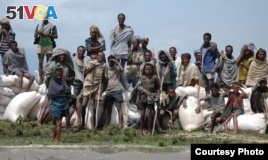October 16,2013
A new report says hundreds of millions of extremely poor people could be at the mercy of natural disasters in the coming years. It says unless they are better prepared to face droughts and floods, extreme poverty cannot be eliminated.
Extreme poverty is defined as living on less than one dollar and 25 cents a day – and there are growing calls to eliminate it by 2030. It could become one of the new goals to replace the Millennium Development Goals, which expire in 2015.

A crowd of stranded villagers gather on the banks of Ethiopia's Lake Tana (the source of the Blue Nile), as sacks of emergency food supplies are unloaded. Weeks of heavy rain have left more than 630 dead and 200,000 homeless and facing the spread of water
However, Britain’s Overseas Development Institute, ODI, says ending extreme poverty is unlikely until governments “come to terms with the increased risk of natural disasters in some of the poorest parts of the world.” It’s released a new report called: The Geography of Poverty, Disasters and Climate Extremes in 2030.
Dr. Tom Mitchell, ODI’s head of Climate Change, is one of the authors. He said, “What we found is there’s a very close overlap between the countries that we expect to have very high levels of poverty still in 2030 and the countries most exposed to natural hazards. And now this shouldn’t really come as a surprise because we know that the poorest and most vulnerable people get hit hardest by extreme events. So there really is a very close link between poverty and disasters.”
The report says there are 11 countries most at risk of disaster- induced poverty: Bangladesh, DRC, Ethiopia, Kenya, Madagascar, Nepal, Nigeria, Pakistan, Sudan, South Sudan and Uganda. Ten other countries have high proportions of people in poverty, plus high hazard exposure and insufficient risk management. But the report singles out India for special mention.
“In 2030, we expect there to still be very significant numbers of poor people living in India – possibly above a hundred million. In addition, this is a country that’s going to be extremely exposed natural hazards. It’s got very good central capacity to manage the problem. But at state level – some of which are as big as countries by themselves – the capacity is much more variable. And so earlier in the year we saw floods in Uttarakhand that killed in excess of 5,000 people, highlighting that you can get it right in one state for one hazard, but there are a whole bunch of other things that need to be dealt with,” said Mitchell.
It’s not that the extreme poor just happen to be unlucky where they live, he said.
“Natural hazards don’t discriminate. It’s actually people who discriminate and governments who discriminate. So what you find is that the poorest and most vulnerable people are living in the most exposed areas – whether in informal settlements on the edge of cities or in remote rural areas with poor access to early warnings or to infrastructure. And in that regard they are in an acute position in terms of their exposure, and they have very little assets to cope.”
They have no insurance to cover the loss of their property and belongings.
“I think we assume in many of the countries that we are researching that where there are efforts to tackle disaster risk they are focused on the poorest and most vulnerable people. But actually that’s just not he case. What you tend to find is that where there are government programs they focus predominantly on big cities or high value infrastructure that might be important to foreign business interests. Very, very rarely do they focus on the poorest and most vulnerable regions -- even though they may be also some of the most exposed to natural hazard,” he said.
He said that countries most in need are getting very little international aid for preparedness and risk reduction --– less than two million dollars a year each. He has a message for those governments that don’t take the report’s findings seriously.
“Look, if you’re serious in ending extreme poverty – and that you’re serious in protecting your economic growth – then disaster risk management needs to be at the heart of your policies – needs to be at the heart of your economic growth policies – and needs to be a part of your social development and poverty reduction policies. Otherwise, if you look at it completely rationally, you’re going to be losing more. More people are going to be affected. And actually not taking this seriously is going to be bad for business,” he said.
The Overseas Development Institute report recommends making natural disaster risk management a cornerstone of efforts to reduce poverty. Those efforts, it says, should “focus on saving livelihoods as well as lives. But much more money would be needed. The report estimates that for every $100 of official development assistance only 40 cents is spent on reducing disaster risk. That’s less than one-half of one dollar.